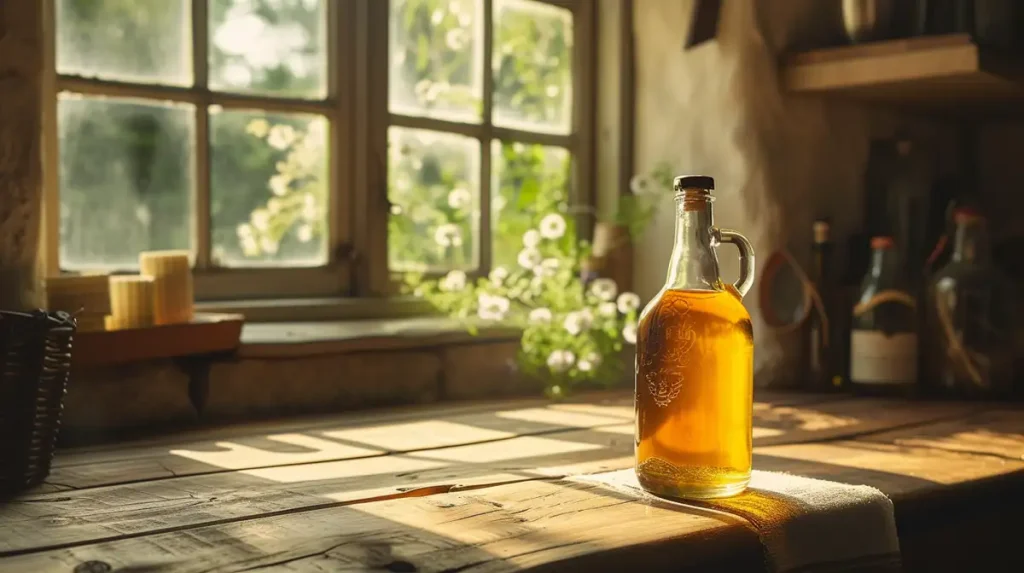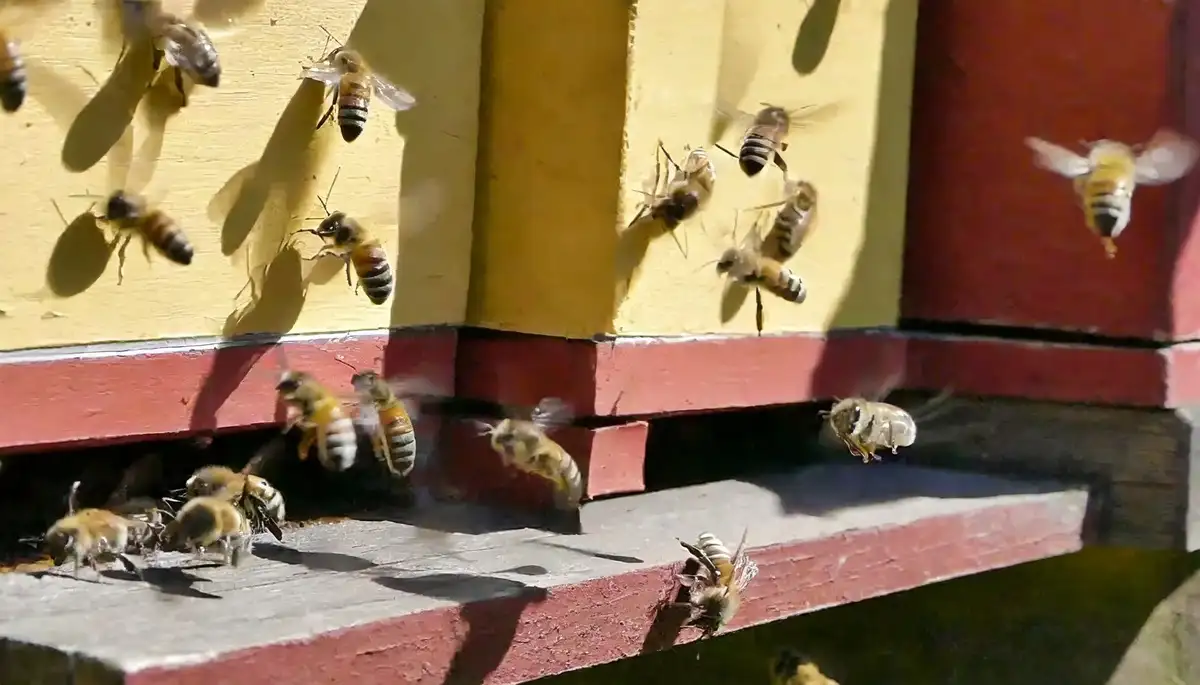Table of Contents
Imagine a world where Vikings and fairy-tale characters clink goblets, sipping on the nectar of the gods. Now, what if I told you that you, too, could partake in this ancient elixir without raiding a village or befriending a wizard? Well, buckle up, because we’re about to explore the magical world of how to make mead at home! This golden beverage, rich in history and flavour, has been enjoyed for centuries, and it’s high time you joined the fun. In this article, we’ll guide you through the mystical process of creating your very own ambrosial brew, right from the comfort of your humble abode. Not only will you learn the secrets behind fermenting honey, but you’ll also discover how mead-making can be a fun, cost-effective, and satisfying hobby. So, raise your horns, dear reader, and let’s embark on this enchanting journey together!
Key Takeaways
- Mead is an ancient alcoholic beverage made by fermenting honey with water and sometimes additional ingredients like fruits, spices, and herbs.
- The primary ingredients for making mead are honey, water, and yeast. The choice of honey and yeast can significantly impact the flavor and quality of the mead.
- The equipment needed for mead-making includes a fermenting vessel, an airlock, a hydrometer, a thermometer, a siphon, and bottles for storage.
- The mead-making process involves several steps: preparing the must, sanitizing equipment, pitching the yeast, fermentation, racking, clearing, aging, bottling, and conditioning.
- Monitoring the fermentation process is essential. Use a hydrometer to track the progress, and take note of temperature, specific gravity, and duration.
- Aging mead is an essential step that allows the flavors to mature and develop, usually taking anywhere from several months to a few years, depending on the desired outcome.
- During the bottling process, it’s crucial to sanitize bottles and caps, carefully transfer the mead to avoid sediment, and securely seal the bottles for proper conditioning.
- A well-made mead can have a long shelf life, often improving in taste and complexity as it ages.
- Mead can be enjoyed in various ways, such as at different temperatures, in cocktails, or paired with foods that complement its unique flavors.
- Making mead at home can be a rewarding hobby, allowing you to experiment with different ingredients and techniques to create a personalized, delicious beverage.
- Racking and clearing techniques, such as cold crashing, fining agents, and filtration, are crucial for enhancing the clarity and appearance of mead.
- Balancing sweetness and acidity is essential for creating a well-rounded mead. Measure and adjust pH and titratable acidity as needed.
- Back-sweetening allows you to fine-tune the sweetness and flavor profile of your mead by adding additional honey or other sweeteners after fermentation.
- Carbonation methods, like natural carbonation through bottle conditioning or force carbonation using a kegging system, can enhance the mouthfeel of mead.
- Proper storage conditions, such as cool and dark environments with consistent temperatures, are necessary for preserving mead’s quality and taste over time.
- Tasting and evaluating mead helps refine your mead-making skills and improve future batches by identifying desirable or undesirable characteristics.
- Exploring different mead styles and traditions, such as melomels, metheglins, pyments, braggots, and traditional mead, can expand your mead-making repertoire.
- Troubleshooting common mead-making mistakes, like using the wrong amount of yeast or dealing with contamination, helps ensure the success of your mead.
- Experimenting with recipe variations, fruits, spices, and herbs can lead to unique and personalized mead creations.
- Keeping track of measurements, ratios, and recipe changes is important for fine-tuning your mead-making skills and creating mead that suits your taste preferences.

Choosing the Right Honey
Choosing the right honey is a crucial step in making mead with your own honey. It’s important to select a honey that has a strong, distinct flavor, as this will be a key component of the final product. There are several factors to consider when selecting honey for mead-making, including the floral source, location, and time of year.
Factors to Consider When Selecting Honey for Mead-Making
The floral source of the honey can have a significant impact on the flavor of the mead. Different types of honey can have distinct flavors, depending on the plants that the bees visited. For example, clover honey has a mild, sweet taste that is well-suited to mead-making, while buckwheat honey has a more robust, earthy flavor that can add complexity to the finished mead.
The location where the honey was produced can also affect its flavor. Honey produced in different regions can have different tastes, depending on the climate and the plants that are prevalent in the area. Some beekeepers even produce honey that is specific to certain regions, such as wildflower honey from a particular area.
The time of year when the honey was produced can also impact its flavor. For example, honey produced in the spring may have a different flavor profile than honey produced in the fall, due to the different plants that are in bloom at different times of the year.
Evaluating Honey Quality and Sweetness
When testing honey for quality and sweetness, there are several things to look for. First, check the color and clarity of the honey. High-quality honey should be clear and free of any impurities or debris. The color of the honey can also indicate its flavor profile, with lighter honey typically having a milder flavor than darker honey.
Taste and Aroma
In addition to visual inspection, it’s important to taste the honey and evaluate its aroma and flavor. High-quality honey should have a pleasant, characteristic scent and taste that reflects its floral source. Some beekeepers even use a sensory evaluation system, similar to that used for wine, to evaluate the quality and flavor of their honey.
Sugar Content
To test the sugar content of the honey, you can use a refractometer. This tool measures the amount of light that is refracted through a sample of honey, which can give you an accurate reading of the sugar content. This is important because the sugar content of the honey will directly impact the final sweetness level of the mead.
By selecting the right honey and evaluating it carefully for quality and sweetness, you can create mead that is truly unique and delicious. With a little practice and experimentation, you’ll be able to fine-tune your mead-making skills and create mead that perfectly reflects the flavors and aromas of your own honey.
Here is a guide structured to help in selecting the perfect honey for mead-making:
| Honey Variety | Source/Floral Origin | Taste | Aroma | Sugar Content | Color | Recommended Mead Style |
|---|---|---|---|---|---|---|
| Clover | Clover flowers | Mild, sweet | Delicate, floral | High | Light amber | Traditional, light meads |
| Wildflower | Mixed wildflowers | Varies widely | Floral, can be complex | Medium to high | Varies widely | Versatile; suitable for various styles |
| Orange Blossom | Orange groves | Sweet, fruity | Citrusy, bright | High | Light to medium amber | Fruit meads, melomels |
| Buckwheat | Buckwheat flowers | Strong, molasses-like | Earthy, robust | High | Dark amber to brown | Bold, dark meads |
| Acacia | Acacia flowers | Very sweet, clean | Light, floral | High | Very light, almost clear | Delicate, light meads |
| Manuka | Manuka bush | Rich, herbal | Distinctive, woody | Medium | Dark amber | Medicinal, herbal meads |
| Tupelo | Tupelo tree blossoms | Smooth, buttery | Floral, fruity | High | Light to medium amber | Premium, sweet meads |
| Heather | Heather flowers | Slightly bitter, smoky | Floral, woody | Medium to high | Amber to dark | Traditional, rich meads |
| Eucalyptus | Eucalyptus flowers | Bold, slightly medicinal | Strong, distinctive | Medium | Dark amber | Herbal, distinctive meads |
| Sage | Sage flowers | Mild, with a hint of spice | Light, herbal | Medium | Light amber | Light, aromatic meads |
When selecting honey for mead-making, consider experimenting with small batches to understand how each variety influences the taste, aroma, and overall character of the mead. The perfect honey choice can elevate your mead from good to exceptional.

Equipment and Ingredients
Once you’ve selected your honey, it’s time to gather the necessary equipment and ingredients for making mead. The essential equipment for mead-making includes a large pot, a fermenting vessel, an airlock, and a siphon hose. The fermenting vessel can be a glass carboy or a food-grade plastic bucket with a lid, depending on your preference.
The pot should be large enough to hold the honey and water mixture, as well as the yeast and other ingredients. A five-gallon pot is typically sufficient for making a standard batch of mead.
- Carter, Anthony (Author)
- English (Publication Language)
- 194 Pages - 02/28/2024 (Publication Date) - Independently published (Publisher)
The fermenting vessel should be able to hold at least five gallons of liquid and have an airtight seal to prevent oxygen from entering the mixture. The airlock is a crucial component for allowing carbon dioxide to escape while preventing air from entering the fermenting vessel.
Ingredients
In addition to honey, you’ll need water, yeast, and yeast nutrients. The yeast is what converts the sugar in the honey into alcohol, and yeast nutrients are added to provide the yeast with the essential nutrients it needs to thrive.
When sourcing ingredients for your mead, it’s important to select high-quality, fresh ingredients. Look for organic or locally-sourced fruits and spices, as these can add complexity and depth to the final product. In addition, choose a high-quality yeast strain that is well-suited to mead-making. Some popular yeast strains for mead-making include Lalvin D47, Lalvin 71B, and EC-1118.
It’s important to follow the instructions for the yeast and yeast nutrients carefully, as the amount and timing of these ingredients can directly impact the final flavor and alcohol content of the mead.
If you want to experiment with different flavors and aromas, you can add fruit, spices, or other flavorings to your mead. For example, adding cinnamon sticks, vanilla beans, or citrus peel can create a unique and flavorful mead.
Sourcing quality ingredients and using the right equipment means you can create mead that is flavorful, complex, and true to the unique flavors of your own honey. With a little practice and experimentation, you’ll be able to create mead that is truly one-of-a-kind.
Here is a detailed table of basic ingredients needed for making traditional mead, along with optional ingredients that can be added to create different flavors or styles:
| Ingredient Category | Ingredient | Quantity for 5 Gallons | Purpose | Notes |
|---|---|---|---|---|
| Primary Ingredient | Honey | 10-15 lbs (4.5-6.8 kg) | Fermentable sugar source | The quality and varietal of honey significantly affect the flavor. |
| Solvent | Water | Up to 5 gallons (19 L) | Dilutes honey and provides a medium for fermentation | Use spring or distilled water for best results. |
| Yeast | Wine or Mead Yeast | 1 Packet (5-10 grams) | Fermentation agent | Specific strains can influence flavor and alcohol content. |
| Nutrients | Yeast Nutrient | 1-2 tsp (5-10 grams) | Supports yeast health and activity | Essential for a healthy fermentation process. |
| Yeast Energizer | 0.5-1 tsp (2.5-5 grams) | Additional support for yeast | Often used in nutrient-deficient musts. | |
| Acid Adjustment (Optional) | Acid Blend | To taste (start with 1 tsp/5 L) | Balances the mead’s pH and flavor | Use cautiously; too much can spoil the taste. |
| Stabilizers (Optional) | Potassium Sorbate | 1 tsp (5 grams) | Halts fermentation | Use before bottling to prevent re-fermentation. |
| Potassium Metabisulfite | 0.5 tsp (2.5 grams) | Antioxidant and antimicrobial | Protects mead from oxidation and spoilage. | |
| Flavorings (Optional) | Fruits, Spices, Herbs | Variable | Adds flavor and aroma | Amounts vary widely depending on desired intensity. |
| Clarifying Agents (Optional) | Bentonite, Isinglass | As per product instructions | Clarifies mead | Helps to remove suspended particles. |
Notes:
- Honey: The amount of honey used can vary depending on the desired sweetness (dry, semi-sweet, sweet) and alcohol content of the final product.
- Water: The quality of water is crucial, as chlorine and other chemicals can negatively affect the fermentation process and taste.
- Yeast: There are many strains suitable for mead making, including those specifically designed for mead, as well as wine and champagne yeasts.
- Nutrients and Energizers: These are critical for a healthy fermentation, especially given honey’s lack of certain nutrients needed by yeast.
- Optional Ingredients: The use of fruits (melomels), spices and herbs (metheglins), or even grains (braggots) can create a wide range of flavors and styles.
- Stabilizers and Clarifying Agents: These are used in the post-fermentation stage to prepare the mead for aging and bottling, ensuring stability and clarity.
This table provides a basic overview, but the art of mead making allows for extensive customization and experimentation.
Step-by-Step Guide to Making Mead
Here’s a detailed step-by-step guide to making mead, structured in a table format for clarity.
This guide covers the basics, from preparation to fermentation and bottling. Mead, often known as honey wine, is one of the oldest alcoholic drinks known to man, made from honey, water, and yeast. The process can be simple or complex, depending on the desired outcome.
| Step | Description | Details |
|---|---|---|
| 1. Sanitize Equipment | Ensure all equipment is thoroughly sanitized to prevent contamination. | Use a no-rinse sanitizer designed for brewing to clean fermenters, spoons, airlocks, bottles, and any other equipment that will come into contact with the mead. |
| 2. Prepare Ingredients | Gather and measure the ingredients for your mead. | Typical ingredients include honey, water, yeast, and optional yeast nutrients. Flavorings such as fruits, spices, or herbs can be added for different mead varieties. |
| 3. Mix Honey and Water | Create the must by mixing honey with water. | The ratio of honey to water will influence the final sweetness and alcohol content. A general guideline is 1 part honey to 2-3 parts water. |
| 4. Add Yeast Nutrient | Enhance yeast health and fermentation efficiency. | Nutrient additions are optional but recommended to ensure a healthy fermentation. Follow the instructions on the nutrient package for proper dosage. |
| 5. Pitch Yeast | Add yeast to the must to initiate fermentation. | Depending on the yeast strain, it may need to be rehydrated before adding. Stir the yeast into the must to ensure it’s evenly distributed. |
| 6. Primary Fermentation | Allow the yeast to ferment the sugars into alcohol. | Place the must in a fermentation vessel with an airlock and store it in a dark, temperature-controlled space. Fermentation can take from a week to several weeks, depending on various factors including temperature, yeast strain, and initial sugar content. |
| 7. Racking | Transfer the mead to a secondary vessel to clarify. | After primary fermentation slows and most of the yeast has settled, siphon the mead into a clean, sanitized secondary fermenter, leaving the sediment behind. This step prevents off-flavors from developing and helps in the clarification process. |
| 8. Secondary Fermentation | Further clarify and mature the mead. | Secondary fermentation can last from a few weeks to several months. Additional racking can be performed if needed to further clarify the mead. |
| 9. Add Additional Flavors (Optional) | Enhance the mead with additional ingredients for flavor. | Fruits, spices, or other flavorings can be added during secondary fermentation to infuse the mead with desired flavors. |
| 10. Monitor and Test | Check the mead’s progress and ensure fermentation is complete. | Use a hydrometer to test the specific gravity. Fermentation is considered complete when readings are consistent over several days. |
| 11. Bottling | Transfer the mead into bottles for aging or consumption. | Once fermentation is complete and the mead is clear, it can be siphoned into sanitized bottles. Seal the bottles with corks or caps. |
| 12. Aging | Allow the mead to age and develop flavors. | Mead can be consumed young, but aging often improves its complexity and smoothness. Aging can range from a few months to several years. |
| 13. Enjoy | Your mead is ready to be enjoyed! | Serve your mead chilled or at room temperature, depending on the type and your personal preference. |
This guide is a general overview, and the specifics can vary based on the recipe and the mead maker’s preferences. Experimentation and patience are key to crafting delicious mead.

Sanitation and Cleanliness – A Key to Success
To ensure a successful mead-making process, it is crucial to maintain a clean and sanitized workspace. This includes sterilizing all equipment and utensils to prevent contamination. Here are some tips to maintain a clean and hygienic environment for your mead-making:
- Clean your work area thoroughly before starting. This includes wiping down all surfaces and removing any debris that could contaminate your mead.
- Use food-safe cleaners and sanitizers to sterilize all equipment, such as fermenters, airlocks, and siphon hoses. This will help to eliminate any bacteria or wild yeast that could negatively affect the fermentation process.
- Always wash your hands before handling any ingredients or equipment.
- Store your mead-making ingredients in a clean and dry area to prevent contamination.
Remember, a clean and sanitized environment is the foundation of a successful mead-making process.
Temperature Control – Perfecting the Fermentation Process
Temperature plays a significant role in the mead-making process. Maintaining optimal temperature during fermentation and aging is crucial to ensure proper yeast activity and prevent unwanted off-flavors. Here are some tips for controlling the temperature during mead-making:
- Choose the right yeast strain. Different yeast strains have different temperature tolerances. Make sure to select a strain that works well within the temperature range you can maintain during fermentation.
- Use a temperature-controlled environment for fermentation, such as a fermentation chamber or a temperature-controlled room. This will help you maintain a consistent temperature throughout the process.
- Monitor the temperature regularly. Use a thermometer to check the temperature of the fermenting mead and adjust it accordingly. Too high or too low temperatures can result in stalled fermentation or the production of off-flavors.
- Maintain a consistent temperature during the aging process. Temperature fluctuations can affect the mead’s flavor and stability.
Maintaining optimal temperature during fermentation and aging means you can ensure that your mead develops the desired flavors and characteristics.

Specific Gravity – A Vital Measurement
Specific gravity is a crucial parameter in mead-making. It measures the density of a liquid compared to the density of water and helps monitor the fermentation progress and estimate the alcohol content. Here’s how to measure and monitor specific gravity in mead-making:
- Use a hydrometer: A hydrometer is an instrument used to measure the specific gravity of a liquid. To use a hydrometer, take a sample of your mead and place it in a hydrometer jar. Then, gently lower the hydrometer into the sample and read the specific gravity where the liquid meets the hydrometer’s scale.
- Record initial and final readings: Take a specific gravity reading before fermentation begins (initial reading) and after fermentation is complete (final reading). This will help you track the progress of fermentation and calculate the mead’s alcohol content.
- Monitor fermentation progress: Periodically check the specific gravity during fermentation to ensure that it’s proceeding as expected. If the specific gravity doesn’t change over time, it could indicate a stalled fermentation that needs attention.
Racking and Clearing Techniques – Enhancing Clarity and Appearance
Racking and clearing your mead is essential for improving its clarity and appearance. There are several techniques to achieve this, including cold crashing, using fining agents, and filtration. Let’s explore these methods in detail:
- Cold crashing: Cold crashing involves reducing the temperature of your mead to encourage the settling of suspended particles. By placing the mead in a cold environment, such as a refrigerator or a temperature-controlled chamber, for a few days to a week, you can effectively clarify the mead and enhance its appearance.
- Fining agents: Fining agents are substances that are added to mead to help remove suspended particles and improve clarity. Common fining agents include bentonite, gelatin, and isinglass. To use a fining agent, follow the manufacturer’s instructions for the specific product, and allow sufficient time for the particles to settle before racking or bottling.
- Filtration: Filtration involves passing the mead through a filter to remove suspended particles and improve clarity. There are various types of filters available, such as plate filters, cartridge filters, and bag filters. When choosing a filter, consider the size of the particles you want to remove and the desired level of clarity for your mead.
Racking, or transferring the mead from one container to another, is essential for separating the clear mead from the sediment that forms at the bottom of the fermenter. To rack the mead:
- Use a siphon or a racking cane to transfer the mead from the fermenter to a clean, sanitized container. Be careful not to disturb the sediment at the bottom of the fermenter.
- Ensure that the receiving container is lower than the fermenter to allow gravity to help with the transfer process.
- Once the mead has been transferred, leave the sediment behind and discard it.
By employing these racking and clearing techniques, you can improve the clarity and appearance of your mead, resulting in a more attractive and enjoyable beverage.
Balancing Sweetness and Acidity – Crafting a Well-Rounded Mead
Understanding the role of acidity in mead and learning how to balance it with the sweetness is crucial for creating a well-rounded and enjoyable final product. Acidity contributes to the overall flavor, mouthfeel, and stability of the mead. To achieve the perfect balance between sweetness and acidity, consider the following steps:
- Measure the pH and titratable acidity (TA) of your mead. pH indicates the overall acidity, while TA measures the actual amount of acid present. A pH meter or pH test strips can be used to measure pH, and a titration kit can measure TA.
- Aim for a balanced pH and TA level. Mead typically has a pH between 3.0 and 3.8, and a TA between 4 and 10 grams per liter. These values can vary depending on the desired flavor profile.
- Adjust acidity as needed. If your mead’s acidity is too low, you can add acid blends or specific acids, such as malic, citric, or tartaric acid, to increase it. If the acidity is too high, you can dilute the mead with water or honey, or use a neutralizing agent like potassium bicarbonate.
If you carefully monitor and adjust the acidity and sweetness of the mead, you can create a well-rounded and enjoyable beverage that pleases the palate.

Back-Sweetening – Fine-Tuning the Sweetness and Flavor Profile
Back-sweetening is the process of adding additional honey or other sweeteners after fermentation to adjust the sweetness level and flavor profile of the finished mead. This technique allows you to fine-tune your mead’s taste to your preferences. To back-sweeten your mead, follow these steps:
- Stabilize the mead to prevent renewed fermentation. Add potassium metabisulfite and potassium sorbate to inhibit yeast activity and prevent the added sugars from fermenting.
- Choose your sweetener. Honey is the traditional choice, but you can also use other sweeteners like maple syrup, agave nectar, or fruit juice to add unique flavors.
- Add the sweetener slowly and in small increments, tasting the mead as you go. This will help you achieve the desired sweetness level without over-sweetening.
- Allow the mead to age and integrate the added sweetener before bottling, as the flavor may change over time.
Carbonation Options – Adding Sparkle to Your Mead
Carbonating mead can add an effervescent texture and enhance its mouthfeel. There are two main methods to carbonate mead: natural carbonation through bottle conditioning and force carbonation using a kegging system.
- Natural carbonation: Bottle conditioning involves adding a small amount of sugar (priming sugar) to the mead before bottling. The residual yeast ferments the added sugar, producing carbon dioxide that becomes trapped in the sealed bottle. This method requires careful monitoring of the fermentation process and appropriate bottle selection to prevent over-carbonation and bottle explosion.
- Force carbonation: Force carbonation involves using a kegging system to carbonate the mead by injecting pressurized carbon dioxide directly into the liquid. This method allows for precise control over the carbonation level and eliminates the risk of bottle explosion. However, it requires specialized equipment and additional space for storage.
By choosing the right carbonation method for your mead, you can add an extra dimension of texture and enhance the overall drinking experience.
Storage and Shelf-Life – Ensuring Longevity and Quality
Proper storage conditions for mead play a critical role in preserving its quality and taste over time. Factors like alcohol content, sweetness, and added ingredients can impact the expected shelf-life of mead. To ensure optimal storage and longevity, consider the following guidelines:
- Store mead in a cool, dark place with a consistent temperature between 50-60°F (10-15°C) and minimal exposure to light. UV rays can degrade mead, so avoid direct sunlight.
- Keep mead bottles stored horizontally to maintain a wet cork and prevent oxidation. This is especially important for cork-sealed bottles.
- Be aware that mead’s shelf-life varies depending on its composition. Higher alcohol content and sweetness generally contribute to a longer shelf-life, while added ingredients like fruit or spices can shorten it. Some meads can age gracefully for many years, while others are best consumed within a year or two.
Storing your mead properly means you can ensure it remains enjoyable and maintains its quality throughout its shelf-life.

Tasting and Evaluating Mead – Refining Your Mead-Making Skills
Tasting and evaluating mead is an essential part of the mead-making process. Identifying desirable or undesirable characteristics means you can refine your skills and improve future batches. Here are some techniques for evaluating mead:
- Assess the appearance: Look for clarity, color, and any visible flaws like haze or sediment.
- Analyze the aroma: Note the intensity and complexity of the mead’s bouquet, detecting scents like honey, fruits, spices, or any off-odors.
- Evaluate the taste and mouthfeel: Consider the mead’s sweetness, acidity, alcohol warmth, and body, as well as its balance and harmony of flavors.
- Reflect on the overall experience: Take note of the mead’s finish and any lingering aftertastes, as well as your overall enjoyment.
Use the insights from your evaluations to make adjustments and refinements in your mead-making process for better results in future batches.
Mead Styles and Traditions – Exploring the World of Mead
Mead offers a diverse range of styles and historical traditions, providing context and inspiration for your mead-making projects.
Here is a comprehensive table designed to showcase the diversity and richness of mead-making traditions:
| Style | Primary Ingredients | Characteristics | Origin / Tradition |
|---|---|---|---|
| Traditional Mead | Honey, Water | Varies from sweet to dry; showcases the honey’s flavor. | Global – Ancient origins |
| Melomel | Honey, Water, Fruit | Fruit-flavored mead, including berries, apples, or any fruit. | Global – Various traditions |
| Cyser | Honey, Water, Apples | A type of melomel made specifically with apples. | European – Medieval tradition |
| Pyment | Honey, Water, Grapes | A blend of mead and grapes; can be similar to wine. | European – Ancient to medieval |
| Metheglin | Honey, Water, Spices and Herbs | Spiced or herbed mead, with ingredients like cinnamon, ginger, or even lavender. | European – Medieval tradition |
| Braggot | Honey, Water, Malted Barley, Hops | A hybrid of beer and mead, often with added spices. | British Isles – Medieval tradition |
| Rhodomel | Honey, Water, Rose petals or hips | Rose-flavored mead, often with a delicate and floral taste. | Ancient Greek and Roman tradition |
| Capsicumel | Honey, Water, Chili Peppers | Spicy mead with a kick from hot peppers. | Modern innovation |
| Bochet | Honey (caramelized), Water | Made with caramelized honey, giving it a rich, toasty flavor. | French – Medieval tradition |
| Tej | Honey, Water, Gesho Leaves | Ethiopian traditional mead, usually homemade, with a unique bitterness from Gesho. | Ethiopian tradition |
| Poltorak | Honey, Water | A very sweet and strong mead, made with a higher proportion of honey. | Polish tradition |
| Acerglyn | Honey, Water, Maple Syrup | Mead made with the addition of maple syrup, offering a distinct maple flavor. | North American innovation |
| Bilbemel | Honey, Water, Blueberries | A type of melomel made specifically with blueberries, offering a tart and sweet profile. | Modern innovation, rooted in melomel |
| Morat | Honey, Water, Mulberries | Another variety of melomel, made with mulberries, known for its unique flavor and color. | Historical, with modern variations |
| Show Mead | Honey, Water | A term sometimes used for traditional mead to emphasize its simplicity and the quality of the honey used. | Modern terminology |
| Session Mead | Honey, Water | Lower alcohol content mead, meant for casual drinking. Similar to session beers. | Modern innovation |
| Great Mead | Honey, Water | Often aged for several years, developing complex flavors. | Historical term, various traditions |
This table represents just a snapshot of the diverse world of mead-making, as new styles and techniques continue to emerge while traditional practices are preserved and celebrated. Each style offers a unique tasting experience, influenced by the ingredients used and the fermentation process.
Troubleshooting and Common Mistakes
While making mead with your own honey can be a fun and rewarding process, there are a few common mistakes to avoid. Here are some troubleshooting tips to help you avoid these mistakes and create delicious mead:
- Using too much or too little yeast: Using too much yeast can result in a mead that is too dry, while using too little yeast can result in a mead that is too sweet. It’s important to follow the instructions for the yeast carefully and use the right amount for the size of your batch.
- Contamination: Contamination can happen if your equipment is not properly sanitized. Be sure to sanitize all of your equipment, including your fermenting vessel, airlock, and siphon hose, to prevent contamination.
- Off-flavors and unusual smells: If you notice any off-flavors or unusual smells during the fermentation process, it’s best to discard the batch and start over. This can be a sign of contamination or other issues with the fermentation process.
- Slow or stalled fermentation: If your fermentation seems to be slow or stalled, it may be due to a lack of nutrients for the yeast. Try adding more yeast nutrients or stirring the mixture to keep the yeast in suspension.
- Too much or too little aging: Aging is an important step in mead-making, but it’s important to get the timing right. If you age the mead for too long, it may develop off-flavors or become oxidized. If you don’t age the mead long enough, it may be too sweet or lack complexity.
If you do run into any problems while making mead, don’t be discouraged. Many of the most experienced mead-makers have experienced setbacks along the way. With a little practice and patience, you can develop your skills and create delicious mead using your own honey. Be sure to keep track of your measurements and ratios, and don’t be afraid to experiment with different recipe variations to find the perfect recipe that suits your tastes.
Recipe Variations and Experimentation
One of the best things about making mead with your own honey is the endless opportunities for experimentation and creativity. You can experiment with different recipe variations to create unique flavor combinations and customize your mead to your tastes. Some beekeepers even use honey from specific floral sources to create mead with distinct flavors and aromas.
Keeping Track of Measurements and Ratios
If you’re interested in experimenting with different recipe variations, it’s important to keep track of your measurements and ratios. Even small tweaks to your recipe can significantly impact the final flavor and aroma of your mead.
Experimenting with Fruits, Spices, and Herbs
One fun way to experiment with mead-making is by adding different fruits, spices, or herbs to your mead. For example, adding fresh or frozen berries can create a fruity, tart mead, while adding cinnamon or clove can create a spicy, warming flavor. You can also experiment with different types of honey or yeast strains to see how they impact the final product.
Taking Notes on Recipe Changes
When experimenting with different recipe variations, it’s important to take notes and keep track of the changes you make to your recipe. This will allow you to fine-tune your mead-making skills over time and create mead that is perfectly tailored to your taste preferences.
Aging Your Mead
Another way to experiment with mead-making is by aging your mead for different lengths of time. Aging can significantly impact the final flavor and aroma of your mead, so it’s important to experiment with different aging times to find what works best for your tastes.
Overall, the key to successful mead-making is to have fun and be willing to experiment. With a little practice and patience, you can create delicious mead using your own honey that is uniquely tailored to your tastes.
How to Make Mead at Home – In Conclusion
Making mead with your own honey is a fun and rewarding process that allows you to showcase the unique flavors and aromas of your honey. By following the steps outlined in this article and experimenting with different recipe variations, you can create delicious mead that is truly one-of-a-kind. So why not give it a try? With a little practice and patience, you’ll be on your way to becoming a mead-making expert.
FAQs
Q: How long does it take to make mead at home? A: The fermentation process for mead typically takes between 2 to 6 weeks. After fermentation, the mead needs to age for at least a few months to develop its flavors, with some varieties benefiting from a year or more of aging.
Q: What equipment do I need to make mead at home? A: You will need a fermentation vessel (such as a glass carboy or food-grade plastic bucket), an airlock, a siphon or auto-siphon, a hydrometer, sanitizer, bottles or jars for aging and storage, and a corker or capping tool if using bottles.
Q: Which type of honey is best for making mead? A: You can use any type of honey to make mead, but choosing a high-quality, raw, and unfiltered honey will produce a better-tasting mead. Different honey varieties will impart unique flavors to your mead, so experiment with various types to find your favorite.
Q: How do I choose the right yeast for making mead? A: There are many strains of yeast available, each with different properties. For mead, you can use wine or champagne yeast, which can tolerate higher alcohol levels and ferment well in a honey-based environment. Choose a yeast strain based on your desired alcohol content and flavor profile.
Q: Can I add fruit and spices to my mead? A: Yes, you can add fruits, spices, and herbs to your mead to create different flavors and varieties. Popular additions include berries, apples, cinnamon, cloves, ginger, and vanilla. You can experiment with various combinations to create unique mead recipes.
Q: How do I know when my mead is ready for bottling? A: Your mead is ready for bottling when fermentation has stopped and the mead has cleared. You can use a hydrometer to measure the specific gravity and ensure that it has reached a stable reading for several days. This indicates that fermentation is complete.
Q: What is the best way to store and age mead? A: Mead should be stored in a cool, dark place, away from direct sunlight and temperature fluctuations. You can use bottles or jars with airtight seals to store your mead. Aging mead for several months to a year or more will help it develop more complex flavors and smooth out any harsh notes.
Q: Can I make sparkling mead? A: Yes, you can create sparkling mead by adding a small amount of sugar or honey to the mead just before bottling. This additional sugar will cause a secondary fermentation in the bottle, creating carbon dioxide and, in turn, producing sparkling mead. Make sure to use appropriate bottles and closures to prevent over-pressurization.
Q: Is it possible to make a non-alcoholic mead? A: Traditional mead is an alcoholic beverage due to the fermentation of honey. However, you can make a non-alcoholic version by combining honey, water, and flavorings such as fruits, spices, and herbs, and then heating the mixture to pasteurize it. This will create a sweet, flavorful drink that resembles mead without the alcohol content.
Q: How do I sanitize my equipment for mead making? A: Sanitizing your equipment is crucial to avoid contamination and ensure a successful fermentation. Use a food-grade sanitizer, such as Star San or iodophor, to clean all your tools and equipment, including the fermentation vessel, airlock, siphon, and hydrometer. Follow the instructions on the sanitizer label for proper dilution and contact time.
Q: How do I determine the alcohol content of my mead? A: To calculate the alcohol content of your mead, you’ll need to take specific gravity readings using a hydrometer. Take an initial reading before fermentation, called the original gravity (OG), and a final reading when fermentation is complete, called the final gravity (FG). Then, use the following formula to estimate the alcohol content: ABV = (OG – FG) × 131.25.
Q: What is backsweetening, and when should I do it? A: Backsweetening is the process of adding honey or other sweeteners to your mead after fermentation has finished to increase sweetness and adjust the flavor profile. To backsweeten, first stabilize your mead using potassium metabisulfite and potassium sorbate to prevent re-fermentation, and then carefully add your chosen sweetener, tasting as you go to achieve the desired level of sweetness.
Q: How do I clarify my mead to achieve a clear appearance? A: Mead will typically clear on its own over time, as the yeast and other particles settle to the bottom. If you’d like to speed up the process, you can use fining agents such as bentonite, sparkolloid, or gelatin to help remove suspended particles. Alternatively, you can also use a filtration system to remove particles and achieve a clear mead.
Q: Can I make mead with a lower sugar content for a dryer taste? A: Yes, you can create a dryer mead by controlling the amount of honey you use and selecting a yeast strain with higher alcohol tolerance. A lower initial sugar content will result in less residual sugar after fermentation, creating a dryer mead. Be aware that the final alcohol content may be higher due to the yeast consuming more of the available sugars.
Q: Is there a way to fix off-flavors in my mead? A: If you detect off-flavors in your mead, aging it for an extended period may help mellow and improve the taste. Alternatively, you can try blending the mead with other batches to balance the flavors or using additives like oak chips to introduce new flavor components. In some cases, off-flavors may be a sign of contamination or a problem with the fermentation process, in which case it may be best to discard the batch and start over.
Disclaimer (honey or bee produce)
If you have a known allergy to honey or any other bee produce, it is important to be aware of the potential risks associated with consuming or using these products. Honey and other bee produce such as pollen, propolis, and royal jelly can cause allergic reactions in some individuals, ranging from mild symptoms to severe, life-threatening reactions.
If you are unsure whether you have an allergy to honey or other bee produce, it is recommended that you consult with a medical professional before consuming or using these products. Additionally, it is important to carefully read labels and ingredient lists on food and personal care products that contain honey or other bee produce, as they may trigger an allergic reaction.
This disclaimer is not intended to diagnose, treat, or cure any medical conditions. It is provided for informational purposes only and should not be relied upon as medical advice. If you experience any adverse reactions after consuming or using honey or other bee produce, seek medical attention immediately.
Last update on 2024-05-02 / Affiliate links / Images from Amazon Product Advertising API







